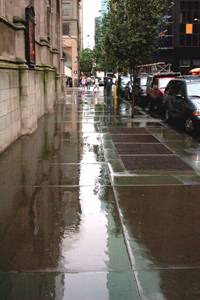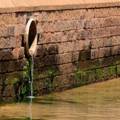Impervious Surface

Presence/absence sampling is often used to measure landscapes rather than organisms. If we want to know how much farmland, forest, or city there is on a map, one way to do that is just to pick a lot of random points and calculate the percentage that are farms, or trees, or houses.
One very useful way to think about landscapes is to calculate "impervious surface". What's that? Read on...
When rain falls on open ground, it soaks in (in scientific terms, it "infiltrates"). But when rain falls on a street, parking lot, or sidewalk, it can't soak in. Instead it flows into nearby storm drains.
Ever wonder where those storm drains go? Mostly, they go directly into the nearest stream, along with any dirt, trash, pesticide, oil or other pollutants it might happen to encounter. Paved surfaces that prevent rainwater from naturally soaking into the ground are called impervious surface, or IS for short.

Pollution from impervious surfaces is linked directly to land use. This is especially true in the areas right around a stream or river, called the buffer zone. Even 15% impervious surface in the buffer zone may cause serious water quality problems.
Below, you can get some practice estimating impervious surface using the presence-absence method. Don't worry, this time the program will do the actual counting...
Now consider that the University of Maryland campus is > 60% impervious surfaces. How healthy do you think streams in this area are?
Copyright University of Maryland, 2007
You may link to this site for educational purposes.
Please do not copy without permission
requests/questions/feedback email: mathbench@umd.edu
